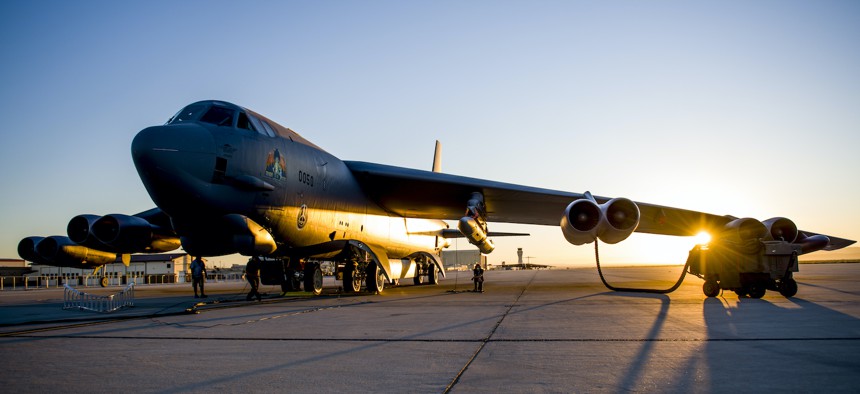
A B-52H Stratofortress undergoes pre-flight procedures at Edwards Air Force Base, California, Aug. 8., 2020. The aircraft conducted a captive-carry flight test of the AGM-183A Air-launched Rapid Response Weapon Instrumented Measurement Vehicle 2. U.S. Air Force / Giancarlo Casem
Failed Hypersonic Test Dims Air Force View of Lockheed Missile
The service had previously disclosed that an ARRW test happened in March, but markedly avoided saying whether it was a success.
The U.S. Air Force’s hypersonic Air-launched Rapid Response Weapon failed in the second round of testing, and the service will decide the fate of the Lockheed Martin-built missile next year, officials confirmed.
The service released a statement Friday that ARRW—its flagship boost-glide hypersonic vehicle—“met several of the objectives” in its second all-up-round testing, conducted March 13 off the coast of southern California. But the statement did not say whether the test was successful.
Air Force Secretary Frank Kendall said Tuesday that the test “was not a success,” and “we did not get the data we needed.”
Kendall, speaking during a House Appropriations defense subcommittee hearing, said the service is still figuring out what happened, and will “revisit” the program in the 2025 budget.
“They have two more test articles that we can use, and we’ll probably have to make a decision on the fate of ARRW after we complete the analysis and hopefully do those two tests,” Kendall said.
The hypersonic missile program had a “very successful” first test of a fully operational ARRW prototype in December, which “was a big step forward” for the program, Kendall said. However, ARRW continued to “struggle” in testing, he said.
Now, Kendall said, the Air Force is “more committed” to its scramjet-powered Hypersonic Attack Cruise Missile, or HACM, than to ARRW.
“We see a definite role for the HACM concept. It’s compatible with more of our aircraft and it’ll give us more combat capability overall,” he said.
After Kendall confirmed the ARRW test failure, Rep. Ken Calvert (R-CA), chairman of the defense subcommittee, said China is less risk-averse than the U.S. when it comes to getting hypersonics to production.
“I don’t like to” call the hypersonic program “[research and development] welfare,” Calvert said, but the funding “seems to go on forever.”
The Air Force’s 2024 budget request does not include any money for buying hypersonic missiles—but it continues to fund R&D for ARRW and HACM, with $150 million for the former and $380 million for the latter.
Focusing on HACM is the “right decision,” as air-breathing cruise missiles, which are powered continuously through the atmosphere on a high-speed jet engine, are a more mature technology, according to Mark Lewis, executive director of the National Defense Industrial Association’s Emerging Technologies Institute.
Air-launched hypersonics such as HACM have “tremendous application” in future warfighting scenarios because the weapon can get closer to the target if an aircraft is moving at high speed, Lewis told Defense One.
While Lewis said he would like to see the Air Force develop both HACM and ARRW, the decision to focus less on ARRW is “actually a good news story. I think it's learning from the research and development phases, learning from the research and development effort, and putting the resources in the right place.”
The Air Force’s ARRW and HACM are just two of the U.S. military’s hypersonic efforts; in all, the Pentagon is requesting $11 billion for hypersonic R&D in 2024.




